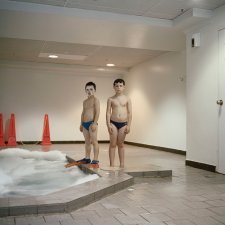Alexis Wright (b. 1950), author and activist, won the Miles Franklin Award in 2007 for her novel Carpentaria and the 2018 Stella Prize for her collective memoir
Tracker. A woman of the Waanyi nation of the Gulf of Carpentaria, Wright was raised by her mother and grandmother in Cloncurry, her non-Aboriginal cattleman father having died when she was five years old. Her first novel,
Plains of Promise, was published in 1997 and was shortlisted for the Commonwealth Writers Prize, a New South Wales Premier’s Literary Award and the Age Book of the Year. Throughout the ensuing decade Wright’s short stories and essays were included in a number of anthologies and in journals such as
Overland,
Australian Humanities Review and
Southerly, and her criticism appeared in
The Age and
Meanjin, among other publications.
Carpentaria, a 500-page-long novel about an Aboriginal family from the Gulf, was written in a style incorporating ‘the way we tell stories and in the voice of our own people and our own way of speaking’, and was initially rejected by several publishers. On its eventual appearance in 2006, however, it won a slew of awards including the Victorian, New South Wales and Queensland’s Premier’s Literary Awards for Fiction; the Australian Book Industry Award for Book of the Year; and the Australian Literary Society’s gold medal, in addition to the Miles Franklin. Her third novel The
Swan Book (2014) was also awarded the ALS gold medal and was shortlisted for the Miles Franklin and the Victorian and New South Wales Premier’s Awards. In addition, through her work as a researcher, activist and consultant with various Aboriginal organisations, she has published widely on Indigenous issues and land rights in Australia and overseas. Her non-fiction titles as author and editor include
Grog War (1997), examining alcohol abuse in the Northern Territory, and
Take Power (1998), an anthology of writing on land rights in Central Australia. Wright has undergraduate qualifications in social studies and creative writing and a doctorate from RMIT. She is currently a Distinguished Fellow of the Writing and Society Research Centre at the University of Western Sydney.
National Photographic Portrait Prize 2010 Finalist
Gift of the artist 2017. Donated through the Australian Government's Cultural Gifts Program.
© Ingvar Kenne
The National Portrait Gallery respects the artistic and intellectual property rights of others. Works of art from the collection are reproduced as per the
Australian Copyright Act 1968 (Cth). The use of images of works from the collection may be restricted under the Act. Requests for a reproduction of a work of art can be made through a
Reproduction request. For further information please contact
NPG Copyright.




















